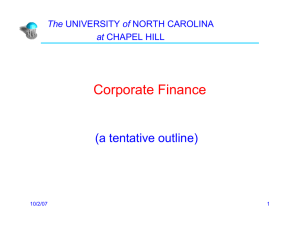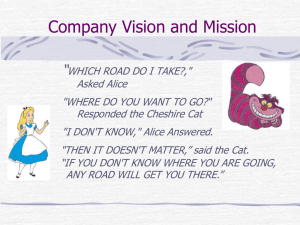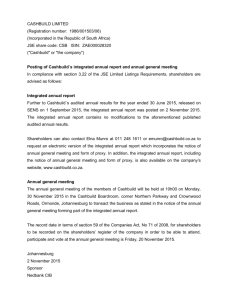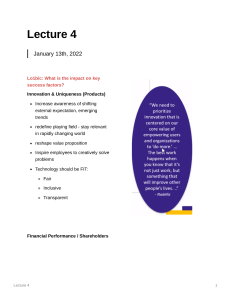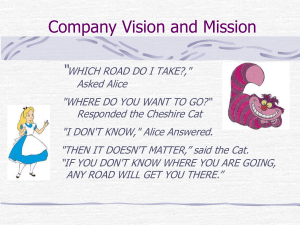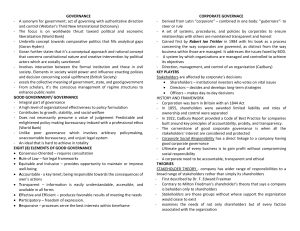The American Competitvness in the 21 Century Act (“AC 21”) and
advertisement
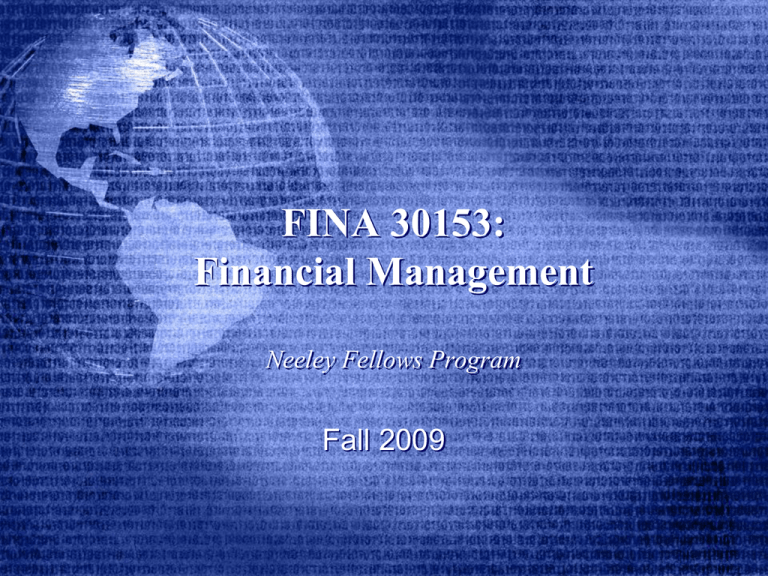
FINA 30153: Financial Management Neeley Fellows Program Fall 2009 Class Overview • Core course in finance • Focus: – How do we value things? Value of financial instruments (stocks, bonds) Value of a service: education Valuation in politics, social issues, etc. Course Topics • Opportunity Cost of Capital and Discounted Cash Flow Valuation • Capital Budgeting • Risk and Return • Capital Structure and Payout Policies • Corporate Governance and Control Readings for the Course • Required Text: Berk and DeMarzo, Corporate Finance, First Edition Other Sources • The Wall Street Journal Premier source for news and analysis You already subscribe! • Financial sites online: Finance.yahoo.com moneycentral.msn.com wrds.wharton.upenn.edu • Bloomberg Useful tools • Excel • Calculators will help you a great deal: – Required capabilities: Time Value of Money and Net Present Value Worksheets • I recommend: – Texas Instruments BA II Plus or HP 10 B – HP 17B or HP19B (advanced) What you are expected to do: • Come to class! • Be enthusiastic • Read the assigned chapters and/or the notes in advance: – Be prepared to discuss the problems and chapter concepts, or to address comments by your classmates or the instructor • Turn in the homework assignments on time • Keep up with the financial news Grades: • • • • • Participation Homework Assignments Presentations Midterm Exam (Oct. 20) Final Exam 15% (150 points) 25% (250 points) 5% ( 50 points) 25% (250 points) 30% (300 points) Participation • Be prepared to discuss problems and chapter concepts in class • The point of class the discussions are to arrive at the right answer -- you do not need to have the right answer to contribute to the discussion! • Do volunteer to ASK and answer questions -that way you contribute not only to your own learning, but to the quality of the learning process of the others as well Today’s Topic • What is finance about? • Corporate Finance and the Financial Manager • The Corporation and Its Environment – Separation of Ownership and Management – Financial Markets • The Goal of the Firm The subject of finance • How do we value things? A general valuation approach • Identify the cash flows that the asset generates over its life • Find what these cash flows are worth today • Adjust for complications like taxes, possibility of default (bankruptcy) • Compare the today’s value of the cash flows to the initial cost of the asset Role of Financial Management • Investment Decisions – Where to invest? • Financial Decisions – How to finance investments? Stocks, Bonds, Private vs. Public Placements The View of the Firm as a Nexus of Contracts • The view of the firm as a collection of contracts: – – – – – – • owners managers employees suppliers customers communities The agency relationship Agency Conflicts between Managers and Shareholders • Will managers work in the shareholders’ best interests or pursue their own interests? • Factors that align managers’ and shareholders objectives: – ownership by management – compensation for performances (bonuses, stock options) – threat of dismissal Corporate Governance and Control • Corporate control -- the power to make investment and financing decisions. • Corporate governance – the mechanisms in place that help insure that shareholders get any return on their investment (the role of the Board of Directors, shareholder voting, proxy fights, actions taken by shareholders to influence corporate decisions) • How do these mechanisms differ across countries, cultures, and legal systems?


